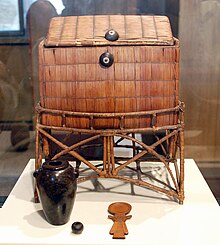Mentuhotep (Queen)
| Mentuhotep in hieroglyphics | ||||||||||||
|---|---|---|---|---|---|---|---|---|---|---|---|---|
(Mentu hotep) / (Montju hotep) Mnṯ.w ḥtp Month is satisfied |
||||||||||||
Queen Mentuhotep was the wife of the Egyptian king Djehuti , who ruled in the Second Intermediate Period (approx. 1700–1550 BC).
supporting documents
Mentuhotep is best known for her coffin, which was seen in Thebes in 1832 and whose inscriptions were copied by John Gardner Wilkinson . The coffin has been lost since then, but copies of the inscriptions have been preserved. Her name appears in a dedication inscription on the canopic box of the Djehuti, who probably never used it himself and gave it to his wife. This box shows the connection between the two people.
Mentuhotep is referred to on this coffin as the daughter of the vizier Senebhenaf and a Sobekhotep and bears the titles " great consort of the king " and " the one who is united with the white crown ".
"Mentuhotep" was actually a man's name. Especially in the Second Intermediate Period, this was also often worn by women.
Special coffin scripts
What particularly distinguishes the coffin, however, are the inscriptions on the inside, which are long religious texts. Some of them can be referred to as coffin texts , while others are early evidence of the so-called Book of the Dead . The coffin is the earliest evidence to date for some important sayings in the Book of the Dead and shows that numerous sayings in this collection of texts were written before the New Kingdom .
Dating
On the basis of the parents of this queen, attempts have often been made to classify her - and thus her husband Djehuti - more precisely within the Second Intermediate Period. It was assumed that her father Senebhenaf was the son of another vizier named Jaib , who in turn was dated under King Jaib . Accordingly, the queen should date two generations after King Jaib. These classifications were made on the basis of identical names among officials who had the names Senebhenaf and Jaib, which was used to reconstruct a vizier family. So far, however, these reconstructions have not really been convincing, as the equations of the persons named are very uncertain.
literature
- Christina Geisen : The dead texts of the lost coffin of Queen Mentuhotep from the 13th Dynasty (= studies on the ancient Egyptian Book of the Dead. Vol. 8). Harrassowitz, Wiesbaden 2004, ISBN 978-3-447-04779-1 .
Individual evidence
- ↑ Inventory number, Egyptian Museum Berlin 1175
- ↑ last: C. Geisen: The dead texts of the lost coffin of Queen Mentuhotep from the 13th dynasty. Pp. 2-3.
| personal data | |
|---|---|
| SURNAME | Mentuhotep |
| BRIEF DESCRIPTION | Wife of the Pharaoh Djehuti |
| DATE OF BIRTH | 17th century BC BC or 16th century BC Chr. |
| DATE OF DEATH | 17th century BC BC or 16th century BC Chr. |
